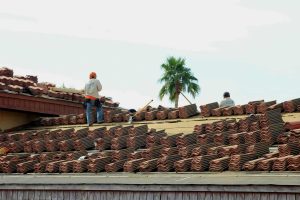Ventilation in roofing might not be the first thing that comes to mind when you think about your roof, but it plays a crucial role in keeping your home healthy and comfortable. Just like a well-ventilated room allows fresh air to circulate and prevents stuffiness, proper ventilation in your attic space helps maintain a healthy environment for your entire house.
Why is Ventilation in Roofing Important?
Your attic can trap heat and moisture, leading to a number of problems:
- Heat Buildup: Attics can become scorching hot during the summer. Poor ventilation allows this heat to radiate down into your living space, increasing your air conditioning usage and driving up energy bills.
- Moisture Damage: Moisture from daily activities like showering and cooking can rise into your attic. Without proper ventilation, this moisture can condense on the underside of your roof deck, leading to mold growth, rot, and structural damage.
- Ice Dams: In cold climates, poor ventilation can contribute to ice dams forming along the eaves of your roof. These ice dams can prevent water from draining properly and lead to leaks and roof damage.
Benefits of Proper Ventilation in Roofing
By ensuring proper ventilation in your attic, you can reap a number of benefits:
- Reduced Energy Costs: A cooler attic means less strain on your air conditioning system, leading to lower energy bills.
- Extended Roof Life: Proper ventilation helps prevent moisture damage, which can significantly extend the lifespan of your roof.
- Improved Indoor Air Quality: Proper ventilation helps reduce moisture levels in your home, which can improve indoor air quality and reduce allergy and asthma symptoms.
- Reduced Risk of Ice Dams: Good ventilation helps prevent the formation of ice dams, protecting your roof from winter weather.
Types of Roof Ventilation
There are two main types of ventilation used in roofing systems:
- Intake Vents: These vents allow fresh air to enter the attic, typically located near the eaves or soffits. Soffit vents are a popular choice for intake ventilation.
- Exhaust Vents: These vents allow hot and humid air to escape the attic, typically located at the peak or ridge of the roof. Ridge vents and turbine vents are common types of exhaust vents.
Ensuring Proper Ventilation
The proper ventilation system for your home will depend on factors such as your roof size, climate, and type of roofing material. It’s important to consult with a qualified roofing professional to determine the best ventilation solution for your needs. We can assess your attic space and recommend the appropriate type and number of vents for optimal airflow.
By taking steps to ensure proper ventilation in your roofing system, you can create a healthier and more comfortable living environment for your family, while also protecting your investment in your home.




